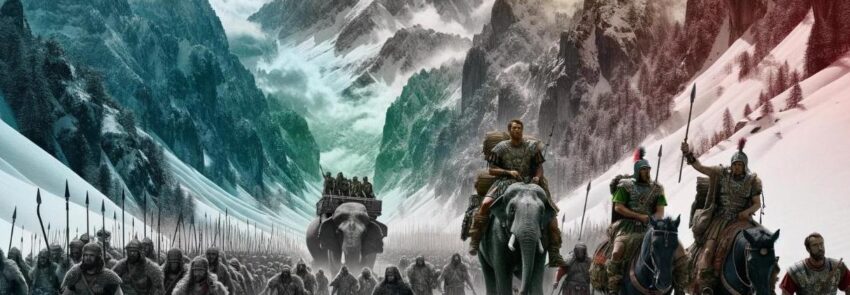Key Battles: Lake Trasimene
The Battle of Lake Trasimene in 217 BCE stands as one of the most notable engagements of Hannibal’s campaign in Italy during the Second Punic War. Near the serene waters of Lake Trasimene in central Italy, this battle was a masterpiece of tactical warfare, showcasing Hannibal’s ability to outmaneuver and outthink his Roman adversaries. After crossing the Alps and securing victories at the Ticinus and Trebia Rivers, Hannibal continued his march southward into the heart of Italy. The Roman consul Gaius Flaminius, eager to confront the Carthaginian general, pursued Hannibal with a large force. Unbeknownst to Flaminius, Hannibal had chosen the terrain around Lake Trasimene for his next ambush, recognizing its potential to trap the advancing Roman army.
The battlefield at Lake Trasimene was ideal for an ambush. The road ran along the northern shore of the lake, flanked by hills to the north and the water to the south. Hannibal placed his troops in concealed positions within the hills, with his light infantry and cavalry hidden among the foliage. On the morning of the battle, the Roman army marched into the narrow defile without scouting ahead, a critical oversight. As the Romans advanced, Hannibal’s troops sprang the trap, attacking from all sides. The Carthaginian cavalry blocked the rear, cutting off any chance of retreat. The Romans, caught off guard and unable to form a coherent defense, were quickly overwhelmed. The chaos was compounded by a thick morning fog that had settled over the lake, reducing visibility and adding to the confusion. The Battle of Lake Trasimene was one of the largest ambushes in military history, resulting in a devastating defeat for the Romans. Estimates suggest that up to 15,000 Roman soldiers were killed, with many others captured. Flaminius himself fell in the battle, further demoralizing his troops. This victory solidified Hannibal’s reputation as a brilliant tactician and struck fear into the heart of Rome.
Following the victory at Lake Trasimene, Hannibal continued to exploit his momentum, moving through Italy and seeking to dismantle the Roman alliances with local cities and tribes. Despite this and subsequent victories, Hannibal’s long-term strategic goal of securing decisive support within Italy remained elusive, setting the stage for further confrontations in his relentless campaign against Rome. In the years following 217 BCE, Hannibal focused on consolidating his gains, striking alliances with discontented Italian tribes, and weakening Rome’s influence across the region. His next significant encounter with Roman forces occurred at the Battle of Nola in 215 BCE. Here, he faced the Roman general Marcus Claudius Marcellus in a series of skirmishes. Although these engagements were inconclusive, they demonstrated the Roman adaptation to Hannibal’s tactics and the growing resilience of Roman commanders.
In 212 BCE, the Battle of Capua highlighted the strategic shift in Hannibal’s campaign. The city of Capua had allied itself with Hannibal, providing a critical base of operations. However, the Romans, under the leadership of Appius Claudius Pulcher and Quintus Fulvius Flaccus, laid siege to the city. Despite Hannibal’s attempts to lift the siege, Capua eventually fell to the Romans, dealing a significant blow to his strategy of forging alliances within Italy. That same year, Hannibal achieved a notable victory at the Battle of the Silarus River. Here, he decisively defeated a Roman force attempting to relieve Capua, showcasing his continued ability to outmaneuver and crush Roman armies despite the broader strategic challenges he faced.
Throughout these campaigns, Hannibal’s forces increasingly struggled with logistical issues. The Carthaginian government’s reluctance to send adequate reinforcements and supplies severely hampered his efforts. Additionally, his inability to directly threaten Rome itself meant that the core of Roman power remained largely unchallenged. The Battle of the Metaurus in 207 BCE marked another turning point. Hannibal’s brother, Hasdrubal, had marched from Spain to join forces with Hannibal in Italy, bringing much-needed reinforcements. However, the Roman consuls Gaius Claudius Nero and Marcus Livius Salinator intercepted and defeated Hasdrubal’s army, killing him in the process. This defeat not only prevented the crucial union of Carthaginian forces but also left Hannibal isolated in southern Italy.
As Roman pressure mounted, Hannibal was forced into a more defensive posture, conducting a war of attrition. Despite his continued tactical brilliance, the cumulative effects of prolonged warfare, dwindling resources, and the steadfast Roman resistance began to take their toll. Hannibal’s campaign in Italy demonstrated his unmatched skill as a commander but also underscored the strategic challenges of waging a prolonged conflict in enemy territory without sustained logistical support.
 |
 |
 |


